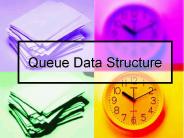Data Structures - PowerPoint PPT Presentation
1 / 19
Title:
Data Structures
Description:
Title: Queues data structure which implements a first-in, first-out list; e.g. print queue, which contains a list of jobs to be printed in order. – PowerPoint PPT presentation
Number of Views:110
Avg rating:3.0/5.0
Title: Data Structures
1
Data Structures
Binary Trees
- Azhar Maqsood
- School of Electrical Engineering and Computer
Sciences (SEECS-NUST)
2
Visiting and Traversing a Node
- Many applications require that all of the nodes
of a tree be visited. - Visiting a node may mean printing contents,
retrieving information, making a calculation,
etc. - Traverse To visit all the nodes in a tree in a
systematic fashion. - A traversal can pass through a node without
visiting it at that moment.
3
Depth First and Breadth First Traversal
- Depth-first traversals using the top-down view
of the tree structure. Traverse the root, the
left subtree and the right subtree. - Breadth-first or level-order traversal visit
nodes in order of increasing depth. For nodes of
same depth visit in left-to-right order.
4
Traversal strategies
- Preorder traversal
- Work at a node is performed before its children
are processed. - Postorder traversal
- Work at a node is performed after its children
are processed. - Inorder traversal
- For each node
- First left child is processed, then the work at
the node is performed, and then the right child
is processed.
5
Tree Traversal Types
6
Preorder traversal
- In the preorder traversal, the root node is
processed first, followed by the left subtree and
then the right subtree.
- Preorder root node of each subtree before the
subsequent left and right subtrees.
7
Preorder Traversal
8
Preorder Traversal
- Visit root before traversing subtrees.
F
9
Inorder Traversal
- In the inorder traversal, the left subtree is
processed first, followed by the root node, and
then the right subtree.
- Inorder root node in betweenthe left and right
subtrees.
10
Inorder Traversal
11
Inorder Traversal
- In an inorder traversal a node is visited after
its left subtree and before its right Subtree - Application draw a binary tree or Arithmetic
expression printing
((2 (a - 1)) (3 b))
12
Example of Binary Tree (inorder)
13
Inorder Traversal
- Visit root between left and right subtree.
F
14
Postorder traversal
- In the postorder traversal, the left subtree is
processed first, followed by the right subtree,
and then the root node.
- Postorder root node after
- the left and right subtrees.
15
Postorder traversal
Postorder Traversal
16
Postorder traversal
- In a postorder traversal, a node is visited after
its descendants - Application compute space used by files in a
directory and its subdirectories
17
Postorder traversal
- Visit root after traversing subtrees.
F
18
Expression Trees
a
g
b
c
f
d
e
Expression tree for ( a b c) ((d e f)
g)
There are three notations for a mathematical
expression 1) Infix notation ( a (b
c)) (((d e) f) c) 2) Postfix notation a b
c d e f g 3) Prefix notation a
b c d e f g
19
Expression Tree traversals
- Depending on how we traverse the expression tree,
we can produce one of these notations for the
expression represented by the three. - Inorder traversal produces infix notation.
- This is a overly parenthesized notation.
- Print out the operator, then print put the left
subtree inside parentheses, and then print out
the right subtree inside parentheses. - Postorder traversal produces postfix notation.
- Print out the left subtree, then print out the
right subtree, and then printout the operator. - Preorder traversal produces prefix notation.
- Print out the operator, then print out the right
subtree, and then print out the left subtree.













![Data Structures [1] PowerPoint PPT Presentation](https://s3.amazonaws.com/images.powershow.com/7170786.th0.jpg?_=20150917062)

















